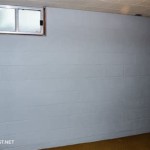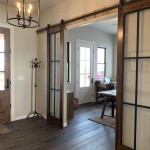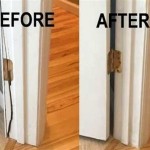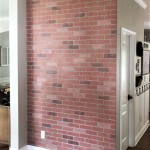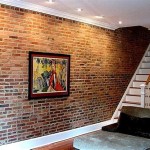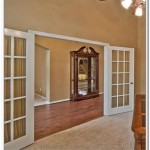How To Cover Up Interior Cinder Block Wall
Cinder block walls, while structurally sound and often cost-effective, can present an aesthetic challenge in interior spaces. Their utilitarian appearance rarely complements desired interior design styles. Fortunately, several effective methods exist for covering cinder block walls, transforming them into visually appealing surfaces that enhance the overall ambiance of a room. The choice of method often depends on factors such as budget, desired aesthetic, and the condition of the existing wall. This article will explore various techniques for covering interior cinder block walls, providing detailed instructions and considerations for each approach.
Preparing the Cinder Block Wall
Before undertaking any covering project, proper preparation of the cinder block wall is essential. This involves cleaning the surface, addressing any structural issues, and applying a suitable primer. Neglecting these steps can compromise the long-term success and appearance of the chosen covering method.
The first step is thorough cleaning. This removes dirt, dust, efflorescence (a white, powdery substance that appears on masonry), and any loose debris. A stiff brush and a solution of water and mild detergent are typically sufficient. For stubborn efflorescence, a specialized masonry cleaner may be necessary, following the manufacturer's instructions carefully. After cleaning, rinse the wall thoroughly with clean water and allow it to dry completely.
Next, inspect the wall for any structural damage, such as cracks or crumbling mortar. Small cracks can often be repaired with masonry crack filler, while larger cracks or areas of significant damage may require professional attention. Ignoring structural problems can lead to further deterioration and compromise the stability of the wall.
Finally, apply a primer specifically designed for masonry surfaces. A good primer improves adhesion of the covering material, seals the porous surface of the cinder block, and helps prevent moisture from penetrating the wall. Choose a primer recommended for the chosen covering material and apply it according to the manufacturer's instructions. Multiple coats may be necessary for optimal coverage and performance.
Applying Furring Strips and Drywall
One of the most common and effective methods for covering cinder block walls is to install furring strips and then cover them with drywall. This creates a smooth, paintable surface that conceals the cinder block completely and provides a cavity for insulation and wiring.
Furring strips are typically made of wood or metal and are attached to the cinder block wall to create a framework for the drywall. Wood furring strips are generally less expensive, but metal furring strips are more resistant to moisture and rot. The spacing of the furring strips depends on the thickness of the drywall and the desired level of structural support. A common spacing is 16 inches on center.
To attach the furring strips to the cinder block wall, use masonry screws or construction adhesive. Masonry screws require pre-drilling pilot holes in the cinder block, while construction adhesive provides a strong bond without the need for drilling. Ensure the furring strips are level and plumb before attaching them permanently. Shims can be used to correct any irregularities in the wall surface.
Once the furring strips are installed, drywall can be attached using drywall screws. Start at one corner of the wall and work your way across, ensuring the drywall sheets are securely fastened to the furring strips. Leave a small gap between the drywall sheets to allow for expansion and contraction.
After the drywall is installed, apply drywall tape and joint compound to the seams and screw holes. Sand the joint compound smooth and repeat as necessary until the surface is perfectly smooth and even. Finally, prime the drywall and paint it with the desired color.
This method offers several advantages. It creates a smooth, seamless surface that is easy to paint or wallpaper. It also provides an opportunity to add insulation to the wall, improving energy efficiency. Furthermore, the cavity created by the furring strips allows for the installation of electrical wiring and plumbing.
Applying Thin Brick or Stone Veneer
For a more rustic or textured look, thin brick or stone veneer can be applied directly to the cinder block wall. This method provides a durable and attractive covering that mimics the appearance of real brick or stone without the need for extensive structural modifications.
Thin brick and stone veneer are typically made from lightweight concrete or clay and are available in a wide variety of colors, textures, and styles. They are designed to be applied to a prepared surface using a thin-set mortar.
Before applying the veneer, ensure the cinder block wall is clean, dry, and free of any loose debris. Apply a scratch coat of mortar to the wall to provide a better bonding surface for the veneer. Allow the scratch coat to dry completely before proceeding.
Mix the thin-set mortar according to the manufacturer's instructions. Apply a thin layer of mortar to the back of the veneer and press it firmly against the wall. Use spacers to maintain consistent spacing between the veneer pieces. Work your way across the wall, ensuring each piece is level and plumb.
After the mortar has dried, grout the joints between the veneer pieces. Choose a grout color that complements the color of the veneer. Apply the grout using a grout float and wipe away any excess with a damp sponge.
Thin brick and stone veneer offer a unique and durable covering option for cinder block walls. They are relatively easy to install and can significantly enhance the aesthetic appeal of a room. They also provide some degree of insulation and soundproofing.
Applying Directly to the Wall: Options and Considerations
While furring strips and veneer offer substantial changes, alternative methods involve applying materials directly to the cinder block surface. These methods require meticulous surface preparation and careful consideration of the material's properties to ensure proper adhesion and durability.
Direct application often involves using a thick coating such as stucco or a specialized masonry coating. Stucco, a cement-based plaster, can create a textured or smooth finish directly on the cinder block. Masonry coatings, often epoxy-based, are designed to seal and protect the cinder block while providing a paintable surface.
The key to successful direct application lies in surface preparation. The cinder block must be thoroughly cleaned and primed with a bonding agent. This bonding agent acts as an adhesive bridge between the cinder block and the coating material, ensuring a strong and lasting bond. Applying a bonding agent is crucial, especially for porous materials like cinder block, which can absorb moisture from the coating and compromise its adhesion.
When applying stucco, several coats may be necessary to achieve the desired thickness and texture. Each coat must be allowed to dry properly before applying the next. Masonry coatings are typically applied in one or two coats, depending on the product's specifications.
Another direct application option involves using a textured paint designed for masonry surfaces. These paints contain aggregates that create a rough or patterned finish, concealing the imperfections of the cinder block. While textured paints are relatively easy to apply, they may not provide the same level of durability or insulation as other methods.
Direct application methods are generally less expensive and less time-consuming than installing furring strips and drywall or applying veneer. However, they may not be suitable for walls with significant irregularities or structural problems. Carefully assess the condition of the cinder block wall before choosing a direct application method.
Painting Cinder Block Walls
Painting is the simplest and most cost-effective method for covering cinder block walls, although it doesn't completely conceal the texture. It is suitable when a minimalist aesthetic is desired, or when budget constraints are significant. Proper preparation and the use of appropriate paints are crucial for achieving a durable and visually appealing finish.
The initial preparation is similar to other methods: cleaning the wall thoroughly to remove dirt, dust, and efflorescence. Any cracks or imperfections should be filled with a masonry patching compound and allowed to dry completely.
A crucial step in painting cinder block walls is applying a block filler primer. Cinder blocks are highly porous, and without a block filler primer, the paint will be absorbed unevenly, resulting in a blotchy and inconsistent finish. Block filler primers are designed to fill the pores and create a smooth, uniform surface for the paint to adhere to.
Apply the block filler primer according to the manufacturer's instructions. Use a thick-nap roller to ensure the primer penetrates the pores of the cinder block. Multiple coats may be necessary for optimal coverage.
Once the primer has dried, apply two coats of a high-quality masonry paint. Choose a paint that is specifically designed for exterior or interior masonry surfaces. These paints are formulated to withstand moisture, alkali, and other environmental factors that can degrade ordinary paint.
Use a thick-nap roller or a paint sprayer to apply the paint evenly. Allow each coat to dry completely before applying the next. Consider using a semi-gloss or gloss finish for easier cleaning and maintenance.
While painting is the most straightforward option, it does not provide the same level of insulation or soundproofing as other methods. It also does not completely conceal the texture of the cinder block. However, with proper preparation and the use of appropriate materials, painting can be a cost-effective way to improve the appearance of interior cinder block walls.

Covering Interior Cinder Block Walls Hometalk

How To Beautifully Transform Your Cinder Block Wall

What Is The Best Way To Dress Up A Cinder Block Wall In Classy Quora

Cinder Block Wall Transformation Nooks In Bloom

Making It All Come Together With An Interior Concrete Block Wall Finish Hometone Home Automation And Smart Guide

10 Ways To Cover Concrete Walls In A Basement Finish

10 Ways To Cover Concrete Walls In A Basement Finish

Diy Projects And Ideas Cinder Block Walls Concrete Basement Makeover

Painting Cinder Block Walls In A Basement Or Re Paint Them

Great Way To Cover Cinder Block Walls And Dress Them Up Use Under House As A Trim Over Fibro With M Garden
Related Posts

